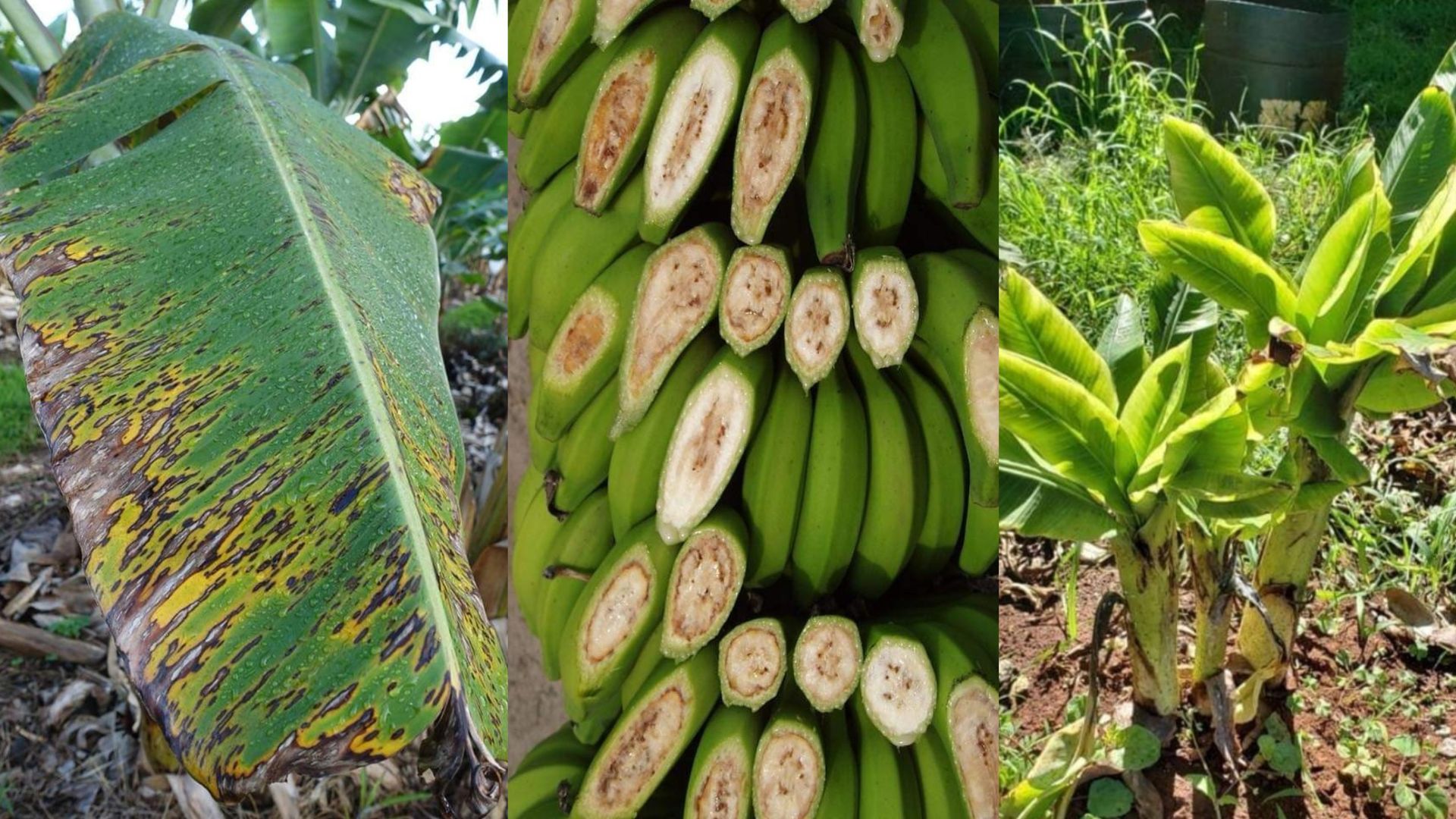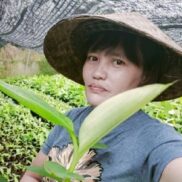Banana Plant Protection – Major Banana Diseases

This post is also available in:
This post is also available in:
![]() Español (Spanish)
Español (Spanish) ![]() Français (French)
Français (French) ![]() हिन्दी (Hindi)
हिन्दी (Hindi) ![]() العربية (Arabic)
العربية (Arabic) ![]() Türkçe (Turkish)
Türkçe (Turkish) ![]() Português (Portuguese (Brazil))
Português (Portuguese (Brazil))
Major Diseases of Banana
Banana Bacterial Wilt (BBW) or Xanthomonas wilt of banana (BXW)
This disease makes banana plants rot from the inside out. Xanthomonas campestris pv. musacearum is the bacterium responsible for the disease. These tiny single-cell creatures start growing once they are within the plant and create the slime that is apparent when an infected plant is sliced apart. Insects and cutting implements that have come into contact with this bacterial slime can spread the disease.
Debudding the male bud as soon as the fruits have formed will stop insects carrying the pathogen-filled exudates created by affected plants from spreading the disease. Debudding will go a long way toward preventing the disease from spreading, along with cleanliness procedures to ensure that cutting equipment is not contaminated.
Remove and cut off the infected plants at the soil level, destroy all emerging suckers and leave the rhizome to rot. (1)
Blood Bacterial Wilt – Blood disease in banana
This bacterial wilt disease is caused by Ralstonia syzygii subsp. celebesensis. Common symptoms of the disease are the wilting and yellowing of the leaves and the browning of the fruit pulp and bunch rachis. It is believed that this pathogen spreads mechanically between healthy and diseased banana inflorescences through insects and other channels involving pruning tools, water flow, and root-to-root contact. The bacterium can be transferred with infected tools from the roots of a diseased plant to the roots of a healthy plant and from the mother plant to the sucker. It is an economically important disease in Indonesia and Malaysia. (2)
The control measures are similar to the ones applied for Xanthomonas wilt. Blood sickness is significantly less common in AAA Cavendish commercial plantations, where routine monitoring, fruit bagging, and excision of the male bell are applied. Never plant suckers from an infected plant; only use disease-free planting materials. Create a nursery and keep the plants separately from the main producing regions if you are unsure of the disease situation. Avoid planting close to infected plots, especially planting suckers downwind from infected plants. Uphold cleanliness on the farm. Tools and equipment should be cleaned (particularly blades used for de-suckering and removing/chopping sick plants). (3)
Moko Disease – It is a bacterial disease caused by Ralstonia solancearum race 2. The infected leaves become yellow, bend, and finally, collapse. The fruits show internal rots; discoloration of the vascular system with ooze.
It is considered a severe banana disease with symptoms resembling bugtok and blood disorders. The stem (leaf sheaths) develops brown streaks and stains, frequently concentrated in the central core (the stem that supports the leaves and flower/fruit stalks). The fruit ripens unevenly and prematurely, and the inside of the fruit has firm, brown, or grey rots. When cut, the vascular tissues of the flower stalk and stem release a creamy bacterial slime. This disease is transmitted by insects or contaminated pruning and sucking tools.
Recommendation of Cultural control method:
Implementation of constant monitoring, quarantined and treated diseased mats (using slow-burning rice hulls), and fruit bagging to stop insects from transmitting the illness to the flowers, the disease only seldom affects large-scale Cavendish plantations. (4)
Sigatoka Disease or Black Sigatoka – Young leaves, or the third or fourth leaf from the top, show the first symptoms. Tiny spindle-shaped dots on the foliage with a yellow halo and a grayish center that run parallel to the veins can be observed in the infected plants. Individual bananas appear tiny, their flesh takes on a buff pinkish hue, and they store badly if the fruit is nearly mature at the time of the disease outbreak. The disease is caused by the Mycosphaerella fijiensis (Morelet) fungus propagated by the conidia, carried by the wind, rain, and old, dried, infected leaves.
The use of cultural management methods is crucial; the goal is to lower the humidity in the plantation to shorten the period that the leaves are moist and the spores have to germinate and spread disease.
Only commercial plantations are advised to use fungicides; examples include:
Protectant Fungicides (these stay on the surface of plants)
Systemic Fungicides (these move inside the plants). (5)
Fusarium Wilt or Panama Disease – The deadly fungal disease Fusarium wilt, is brought on by the soil-borne fungus Fusarium oxysporum f. sp. cubense (Foc). In the first half of the 20th century, it was the first banana disease to spread internationally. The fungus attacks the roots and develops inside the xylem vessels, blocking the water supply and nutrients to the plant. We may observe the vascular tissue’s reddish-brown coloring by cutting up the rhizomes and pseudo stems. The visible signs are older leaf yellowing, leaf sheath cracking, wilting and buckling, and canopy mortality. (6)
Once an outbreak has started, it is crucial to put cultural control measures in place to stop it. Even if the suckers seem healthy, never use suckers from mother plants that exhibit symptoms. The fungus may only recently invaded the suckers and may only be present at a low level in the roots or stem. Utilize disease-certified plants that are growing in tissue culture as your “clean” planting material. If these are unavailable, producers should be urged to only pick suckers from regions devoid of disease indications, ideally from their own farms that have been disease-monitored.
As little as possible should be disturbed. A ring of plants surrounding the afflicted plant might be removed. Avoid replanting the same or another susceptible cultivar in areas where Fusarium wilt is present. (7)
Bunchy Top – The banana tree-stunting and -deforming Banana Bunchy Top Virus. In the rare cases where an infected tree produces fruit, the bunch is small and misshapen. Banana aphids are the vector for the virus that infects plants. Aphids will consume an infected tree’s food and carry the virus in their bodies, dispersing it throughout healthy trees as they consume. Unfortunately, there is no cure for BBTV; once a tree is infected, it must be destroyed. Some signs of this disease are; New leaves are ‘bunched’ at the top and are narrow with yellow margins. The midrib of the leaves has ‘J’-shaped hooks and dark green streaks. The petiole, which is where the stem and the leaf connect, is wrinkled and speckled. Small, deformed fruits or no fruit at all. (9)
Bract Mosaic- BBrMV, or the banana bract mosaic virus, is an uncommon plant pest. The banana bract mosaic virus is also known as Kokkan sickness and banana bract mosaic. In 1979, this illness was first found-reported in the Philippines. The banana bract mosaic virus is very contagious and results in huge economic losses. The dark, reddish-brown mosaic pattern on the banana flower bract is one of the key signs of the banana bract mosaic virus. The rows of flowers and immature fruit on the flower stalk of the banana plant are covered by flower bracts, which are modified leaves. The recommendation to control this disease is to maintain cleanliness. (10)
References:
- https://www.promusa.org/
- https://pubmed.ncbi.nlm.nih.gov
- https://apps.lucidcentral.org/
- https://apps.lucidcentral.org/pppw_v11/text/web_full/entities/banana_moko_disease_525.htm
- https://apps.lucidcentral.org/
- https://www.promusa.org/
- https://apps.lucidcentral.org/
- https://apps.lucidcentral.org/pppw_v11/text/web_full/entities/banana_streak_disease_215.htm
- https://www.biisc.org/pest/banana-bunchy-top-virus/
- https://www.dpi.nsw.gov.au/biosecurity/plant/insect-pests-and-plant-diseases/banana-bract-mosaic-virus
- https://entnemdept.ufl.edu
- https://apps.lucidcentral.org/
- https://www.business.qld.gov.au
- https://www.plantwise.org/FullTextPDF/2020/20207800218.pdf
- https://www.itfnet.org
- Aguayo, J., Mostert, D., Fourrier-Jeandel, C., Cerf-Wendling, I., Hostachy, B., Viljoen, A., & Ioos, R. (2017). Development of a hydrolysis probe-based real-time assay for the detection of tropical strains of Fusarium oxysporum f. sp. cubense race 4. PLoS One, 12(2), e0171767.
Further reading
Banana: Crop History, Nutritional Value and Health Benefits
Banana Plant Information & Environmental Requirements
Banana Plant Care – Commercial Cultivation of Bananas
Soil Requirements and Land Preparation for Bananas
Banana Planting Distances and Support Systems
Banana Water Requirements & Irrigation Systems
Banana Plant Protection – Major Banana Diseases
Banana Plant Protection – Common Pests of Banana Plants









































































